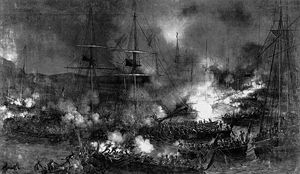Raids on Boulogne
| Raid on Boulogne | |||||||
|---|---|---|---|---|---|---|---|
| Part of the French Revolutionary Wars | |||||||
 Nelson fails against the flotilla near Boulogne - 15th of August 1801, by Louis-Philippe Crépin (1772 Paris – 1851) |
|||||||
|
|||||||
| Belligerents | |||||||
|
|
|
||||||
| Commanders and leaders | |||||||
| Horatio Nelson | Latouche Tréville | ||||||
| Strength | |||||||
| 6 ships of the line 7 frigates 11 sloops-of-war 7 bomb vessels 32 brigs large number of gunboats |
24 brigs and lugger-rigged flats 1 schooner |
||||||
| Casualties and losses | |||||||
| 44 killed 126 wounded 6 ships sunk 20 captured 4 deserted |
10 killed 30 wounded 2 ships sunk |
||||||
The raid on Boulogne in 1801 was a failed attempt by elements of the Royal Navy led by Vice Admiral Lord Horatio Nelson to destroy a flotilla of French vessels anchored in the port of Boulogne, a fleet which was thought to be used for the invasion of England, during the French Revolutionary Wars. At dawn on 4 August, Nelson ordered five bomb vessels to move forward and open fire against the French line. Despite the inferior gunpowder of French artillery and the high number of shots fired by the bomb vessels, the British sustained more casualties and withdrew. The night of 16 August Nelson returned and tried to bring off the flotilla, attacking with seventy boats and nearly two thousand men organized into four divisions, but the attack was successfully repelled by the defenders, led by Admiral Latouche Tréville.
In February 1801 the continental war against the French Republic ceased by a treaty of peace concluded at Lunéville on 9 February between that country and the Austrian Empire, who accepted the French control up to the Rhine and the French client republics in Italy and the Netherlands. In March the British government made the first peace proposal to the French, but the collapse of the League of the North due the death of the tsar Paul I and the French reversals in Portugal and Egypt caused an improvement of the British strategic situation, and the peace negotiations dragged on through the spring.
Because of this, the unemployed French armies gathered at the Channel ports, and the preparation for an invasion began. On 12 July Bonaparte issued an order for the assemblage at Boulogne of nine divisions of gun-vessels and of the same number of battalions of troops, besides several detachments of artillery to serve the guns on board the flotilla. Rear-Admiral Latouche Tréville was appointed the commander in chief and was given directions to exercise the troops in ship-working, in firing the guns, in boarding and in getting in and out of the vessels. Concentrations of troops and flat-bottomed boats were also reported at the ports of Le Havre and Dunkirk. These preparations were exaggerated by the French journals, including the official French government newspaper, Le Moniteur, which published the first consul’s threat of invasion on 21 June. In fact, Bonaparte’s only objective was to intimidate the British government into accepting disadvantageous peace terms.
...
Wikipedia
